warning INFINITI QX50 2020 Owner's Manual
[x] Cancel search | Manufacturer: INFINITI, Model Year: 2020, Model line: QX50, Model: INFINITI QX50 2020Pages: 580, PDF Size: 7.43 MB
Page 552 of 580

lated available tongue weight is greater than
15%. If the calculated tongue weight is less
than 10%, reduce the total trailer weight to
match the available tongue weight.
Always verify that available capacities are
within the required ratings.TOWING LOAD/SPECIFICATION
WARNING
The towing capacities provided in this
manual are for general reference only. The
safe towing capacity of your vehicle is af-
fected by dealer and factory installed op-
tions and passenger and cargo loads. You
must weigh the vehicle and trailer as de-
scribed in this manual to determine the ac-
tual vehicle towing capacity. Do not exceed
the published maximum towing capacity or
the GCWR or the GVWR shown on the
FMVSS/CMVSS label. Doing so can result
in an accident causing serious injury or
property damage.
TOWING LOAD/SPECIFICATION CHART
Axle type AWD2WD/AWD
With Tow Package Without Tow Package
Maximum Towing Capacity*1 3,000 lbs. (1,361 kg)Do not tow with your vehicle
Maximum Tongue Load 300 lbs. (136 kg)Do not tow with your vehicle
Maximum Gross Combined Weight Rating 7,320 lbs. (3,320 kg)Do not tow with your vehicle
*1: The towing capacity values are calculated assuming a base vehicle with driver and any options required to achieve the rating. Additional
passengers, cargo and/or optional equipment will add weight to the vehicle and reduce your vehicle’s maximum towing capacity.
10-22Technical and consumer information
Page 553 of 580

TOWING SAFETY
Trailer hitch
Your vehicle may be equipped with an op-
tional trailer tow package. The trailer tow
package includes a receiver-type frame
mounted hitch. This hitch is rated for the
maximum towing capacity of this vehicle
when the proper towing equipment is used.
Choose a proper ball mount and hitch ball
that is rated for the trailer to be towed. Genu-
ine INFINITI ball mounts and hitch balls are
available from an INFINITI retailer.
If your vehicle is not equipped with the op-
tional trailer tow package, check the towing
capacity of your bumper hitch or receiver-
type frame mounted hitch. Choose a proper
hitch for your vehicle and trailer. A Genuine
INFINITI trailer hitch is available from an
INFINITI retailer. Make sure the trailer hitch is
securely attached to the vehicle to help avoid
personal injury or property damage due to
sway caused by crosswinds, rough road sur-
faces or passing trucks.
WARNING
Trailer hitch components have specific
weight ratings. Your vehicle may be capable
of towing a trailer heavier than the weight
rating of the hitch components. Never ex-
ceed the weight rating of the hitch compo-
nents. Doing so can cause serious personal
injury or property damage.
Hitch ball
Choose a hitch ball of the proper size and
weight rating for your trailer:∙ The required hitch ball size is stamped on most trailer couplers. Most hitch balls
also have the size printed on the top of
the ball.
∙ Choose the proper class hitch ball based on the trailer weight.
∙ The diameter of the threaded shank of the hitch ball must be matched to the ball
mount hole diameter. The hitch ball shank
should be no more than 1/16” smaller
than the hole in the ball mount.
∙ The threaded shank of the hitch ball must be long enough to be properly secured to
the ball mount. There should be at least 2
threads showing beyond the lock washer
and nut.
Ball mount
The hitch ball is attached to the ball mount
and the ball mount is inserted into the hitch
receiver. Choose a proper class ball mount
based on the trailer weight. Additionally, the
ball mount should be chosen to keep the
trailer tongue level with the ground.
Weight carrying hitches
A weight carrying or “dead weight” ball mount
is one that is designed to carry the whole
amount of tongue weight and gross weight
directly on the ball mount and on the receiver.
Weight distribution hitch
This type of hitch is also called a “load-leveling”
or “equalizing” hitch. A set of bars attach to the
ball mount and to the trailer to distribute the
tongue weight (hitch weight) of your trailer.
Many vehicles can’t carry the full tongue
weight of a given trailer, and need some of the
tongue weight transferred through the frame
and pushing down on the front wheels. This
gives stability to the tow vehicle.
A weight-distributing hitch system (Class IV)
is recommended if you plan to tow trailers
with a maximum weight over 5,000 lbs.
(2,268 kg). Check with the trailer and towing
equipment manufacturers to determine if
Technical and consumer information10-23
Page 554 of 580
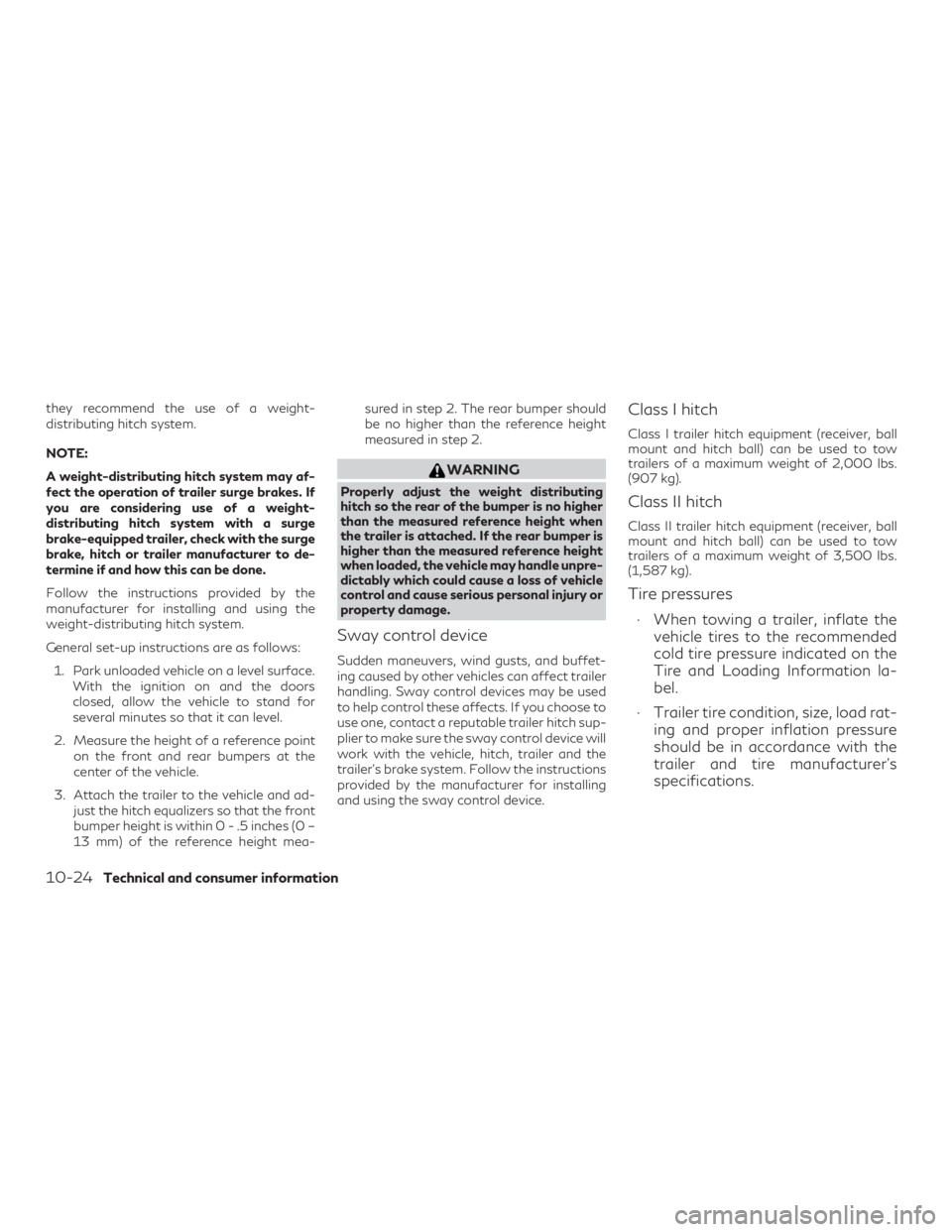
they recommend the use of a weight-
distributing hitch system.
NOTE:
A weight-distributing hitch system may af-
fect the operation of trailer surge brakes. If
you are considering use of a weight-
distributing hitch system with a surge
brake-equipped trailer, check with the surge
brake, hitch or trailer manufacturer to de-
termine if and how this can be done.
Follow the instructions provided by the
manufacturer for installing and using the
weight-distributing hitch system.
General set-up instructions are as follows:1. Park unloaded vehicle on a level surface. With the ignition on and the doors
closed, allow the vehicle to stand for
several minutes so that it can level.
2. Measure the height of a reference point on the front and rear bumpers at the
center of the vehicle.
3. Attach the trailer to the vehicle and ad- just the hitch equalizers so that the front
bumper height is within0-.5inches (0 –
13 mm) of the reference height mea- sured in step 2. The rear bumper should
be no higher than the reference height
measured in step 2.
WARNING
Properly adjust the weight distributing
hitch so the rear of the bumper is no higher
than the measured reference height when
the trailer is attached. If the rear bumper is
higher than the measured reference height
when loaded, the vehicle may handle unpre-
dictably which could cause a loss of vehicle
control and cause serious personal injury or
property damage.
Sway control device
Sudden maneuvers, wind gusts, and buffet-
ing caused by other vehicles can affect trailer
handling. Sway control devices may be used
to help control these affects. If you choose to
use one, contact a reputable trailer hitch sup-
plier to make sure the sway control device will
work with the vehicle, hitch, trailer and the
trailer’s brake system. Follow the instructions
provided by the manufacturer for installing
and using the sway control device.
Class I hitch
Class I trailer hitch equipment (receiver, ball
mount and hitch ball) can be used to tow
trailers of a maximum weight of 2,000 lbs.
(907 kg).
Class II hitch
Class II trailer hitch equipment (receiver, ball
mount and hitch ball) can be used to tow
trailers of a maximum weight of 3,500 lbs.
(1,587 kg).
Tire pressures
∙ When towing a trailer, inflate the
vehicle tires to the recommended
cold tire pressure indicated on the
Tire and Loading Information la-
bel.
∙ Trailer tire condition, size, load rat- ing and proper inflation pressure
should be in accordance with the
trailer and tire manufacturer’s
specifications.
10-24
Technical and consumer information
Page 555 of 580
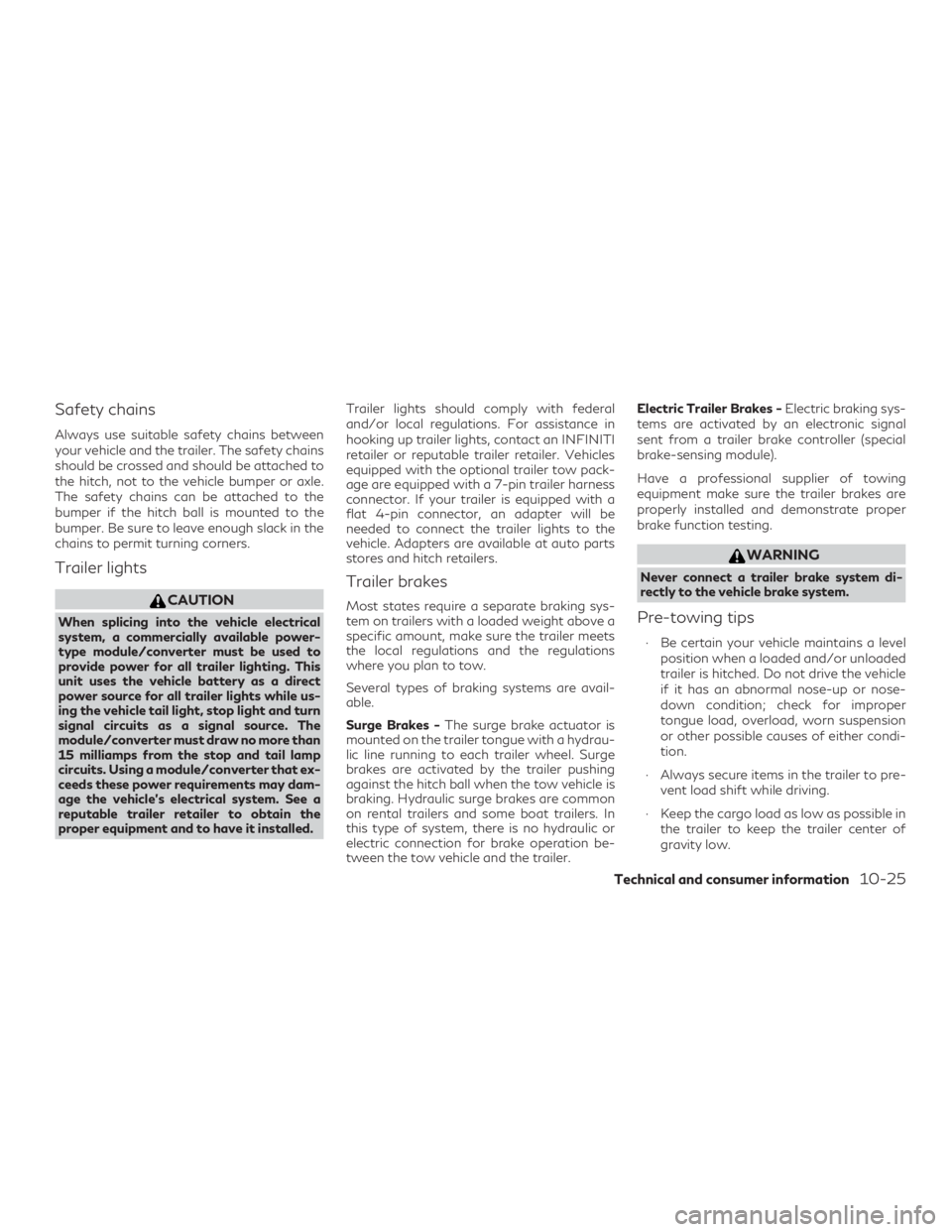
Safety chains
Always use suitable safety chains between
your vehicle and the trailer. The safety chains
should be crossed and should be attached to
the hitch, not to the vehicle bumper or axle.
The safety chains can be attached to the
bumper if the hitch ball is mounted to the
bumper. Be sure to leave enough slack in the
chains to permit turning corners.
Trailer lights
CAUTION
When splicing into the vehicle electrical
system, a commercially available power-
type module/converter must be used to
provide power for all trailer lighting. This
unit uses the vehicle battery as a direct
power source for all trailer lights while us-
ing the vehicle tail light, stop light and turn
signal circuits as a signal source. The
module/converter must draw no more than
15 milliamps from the stop and tail lamp
circuits. Using a module/converter that ex-
ceeds these power requirements may dam-
age the vehicle’s electrical system. See a
reputable trailer retailer to obtain the
proper equipment and to have it installed.Trailer lights should comply with federal
and/or local regulations. For assistance in
hooking up trailer lights, contact an INFINITI
retailer or reputable trailer retailer. Vehicles
equipped with the optional trailer tow pack-
age are equipped with a 7-pin trailer harness
connector. If your trailer is equipped with a
flat 4-pin connector, an adapter will be
needed to connect the trailer lights to the
vehicle. Adapters are available at auto parts
stores and hitch retailers.
Trailer brakes
Most states require a separate braking sys-
tem on trailers with a loaded weight above a
specific amount, make sure the trailer meets
the local regulations and the regulations
where you plan to tow.
Several types of braking systems are avail-
able.
Surge Brakes -
The surge brake actuator is
mounted on the trailer tongue with a hydrau-
lic line running to each trailer wheel. Surge
brakes are activated by the trailer pushing
against the hitch ball when the tow vehicle is
braking. Hydraulic surge brakes are common
on rental trailers and some boat trailers. In
this type of system, there is no hydraulic or
electric connection for brake operation be-
tween the tow vehicle and the trailer. Electric Trailer Brakes -
Electric braking sys-
tems are activated by an electronic signal
sent from a trailer brake controller (special
brake-sensing module).
Have a professional supplier of towing
equipment make sure the trailer brakes are
properly installed and demonstrate proper
brake function testing.
WARNING
Never connect a trailer brake system di-
rectly to the vehicle brake system.
Pre-towing tips
∙ Be certain your vehicle maintains a level position when a loaded and/or unloaded
trailer is hitched. Do not drive the vehicle
if it has an abnormal nose-up or nose-
down condition; check for improper
tongue load, overload, worn suspension
or other possible causes of either condi-
tion.
∙ Always secure items in the trailer to pre- vent load shift while driving.
∙ Keep the cargo load as low as possible in the trailer to keep the trailer center of
gravity low.
Technical and consumer information10-25
Page 559 of 580
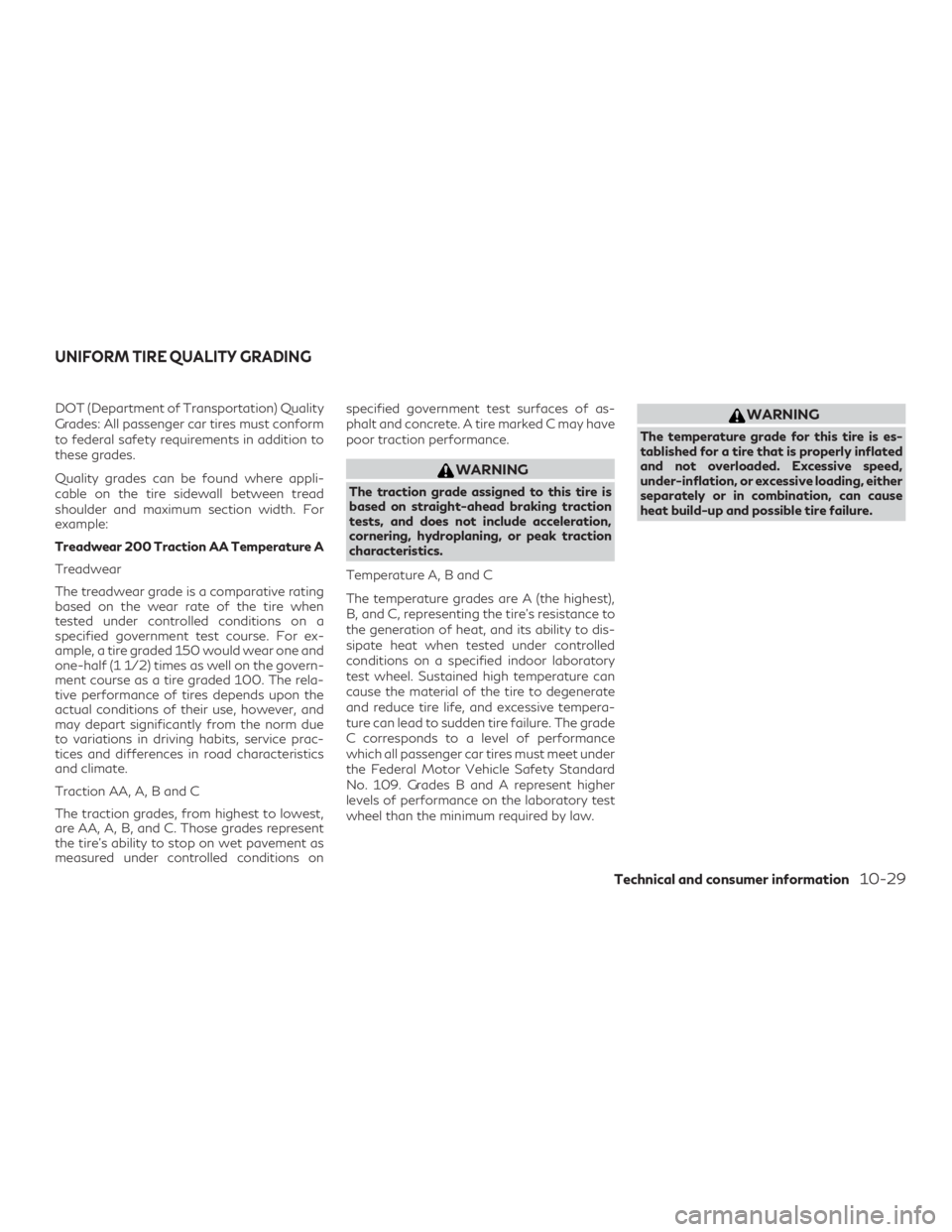
DOT (Department of Transportation) Quality
Grades: All passenger car tires must conform
to federal safety requirements in addition to
these grades.
Quality grades can be found where appli-
cable on the tire sidewall between tread
shoulder and maximum section width. For
example:
Treadwear 200 Traction AA Temperature A
Treadwear
The treadwear grade is a comparative rating
based on the wear rate of the tire when
tested under controlled conditions on a
specified government test course. For ex-
ample, a tire graded 150 would wear one and
one-half (1 1/2) times as well on the govern-
ment course as a tire graded 100. The rela-
tive performance of tires depends upon the
actual conditions of their use, however, and
may depart significantly from the norm due
to variations in driving habits, service prac-
tices and differences in road characteristics
and climate.
Traction AA, A, B and C
The traction grades, from highest to lowest,
are AA, A, B, and C. Those grades represent
the tire’s ability to stop on wet pavement as
measured under controlled conditions onspecified government test surfaces of as-
phalt and concrete. A tire marked C may have
poor traction performance.
WARNING
The traction grade assigned to this tire is
based on straight-ahead braking traction
tests, and does not include acceleration,
cornering, hydroplaning, or peak traction
characteristics.
Temperature A, B and C
The temperature grades are A (the highest),
B, and C, representing the tire’s resistance to
the generation of heat, and its ability to dis-
sipate heat when tested under controlled
conditions on a specified indoor laboratory
test wheel. Sustained high temperature can
cause the material of the tire to degenerate
and reduce tire life, and excessive tempera-
ture can lead to sudden tire failure. The grade
C corresponds to a level of performance
which all passenger car tires must meet under
the Federal Motor Vehicle Safety Standard
No. 109. Grades B and A represent higher
levels of performance on the laboratory test
wheel than the minimum required by law.
WARNING
The temperature grade for this tire is es-
tablished for a tire that is properly inflated
and not overloaded. Excessive speed,
under-inflation, or excessive loading, either
separately or in combination, can cause
heat build-up and possible tire failure.
UNIFORM TIRE QUALITY GRADING
Technical and consumer information10-29
Page 561 of 580

You may notify INFINITI by contacting
our Consumer Affairs Department,
toll-free, at 1-800-662-6200.
For Canada
If you believe that your vehicle has a
defect which could cause a crash or
could cause injury or death, you should
immediately inform Transport Canada
in addition to notifying INFINITI.
If Transport Canada receives com-
plaints, it may open an investigation,
and if it finds that a safety defect ex-
ists in a group of vehicles, it may re-
quest that INFINITI conduct a recall
campaign. However, Transport
Canada cannot become involved in in-
dividual problems between you, your
retailer, or INFINITI.
You may contact Transport Canada’s
Defect Investigations and Recalls Divi-
sion toll free at 1-800-333-0510. You
may also report safety defects online
at: https://wwwapps.tc.gc.ca/Saf-
Sec-Sur/7/PCDB-BDPP/fc-
cp.aspx?lang=eng (English speakers) orhttps://wwwapps.tc.gc.ca/Saf-Sec-
Sur/7/PCDB-BDPP/fc-
cp.aspx?lang=fra (French speakers)
Additional information concerning mo-
tor vehicle safety may be obtained from
Transport Canada’s Road Safety Infor-
mation Centre at 1-800-333-0371 or
online at www.tc.gc.ca/roadsafety
(English speakers) or
www.tc.gc.ca/securiteroutiere (French
speakers).
To notify INFINITI of any safety con-
cerns please contact our Consumer In-
formation Centre toll free at 1-800-
361-4792.
WARNING
A vehicle equipped with All-Wheel Drive
(AWD) should never be tested using a two
wheel dynamometer (such as the dyna-
mometers used by some states for emis-
sions testing), or similar equipment. Make
sure you inform the test facility personnel
that your vehicle is equipped with AWD be-
fore it is placed on a dynamometer. Using
the wrong test equipment may result in
transmission damage or unexpected vehicle
movement which could result in serious ve-
hicle damage or personal injury.
Due to legal requirements in some states and
Canadian Provinces, your vehicle may be re-
quired to be in what is called the “ready con-
dition” for an Inspection/Maintenance (I/M)
test of the emission control system.
The vehicle is set to the “ready condition”
when it is driven through certain driving pat-
terns. Usually, the ready condition can be
obtained by ordinary usage of the vehicle.
If a powertrain system component is repaired
or the battery is disconnected, the vehicle
may be reset to a “not ready” condition. Be-
fore taking the I/M test, check the vehicle’s
inspection/maintenance test readiness con-
dition. Place the ignition switch in the ON
position without starting the engine. If the
READINESS FOR INSPECTION/
MAINTENANCE (I/M) TEST
Technical and consumer information10-31
Page 565 of 580
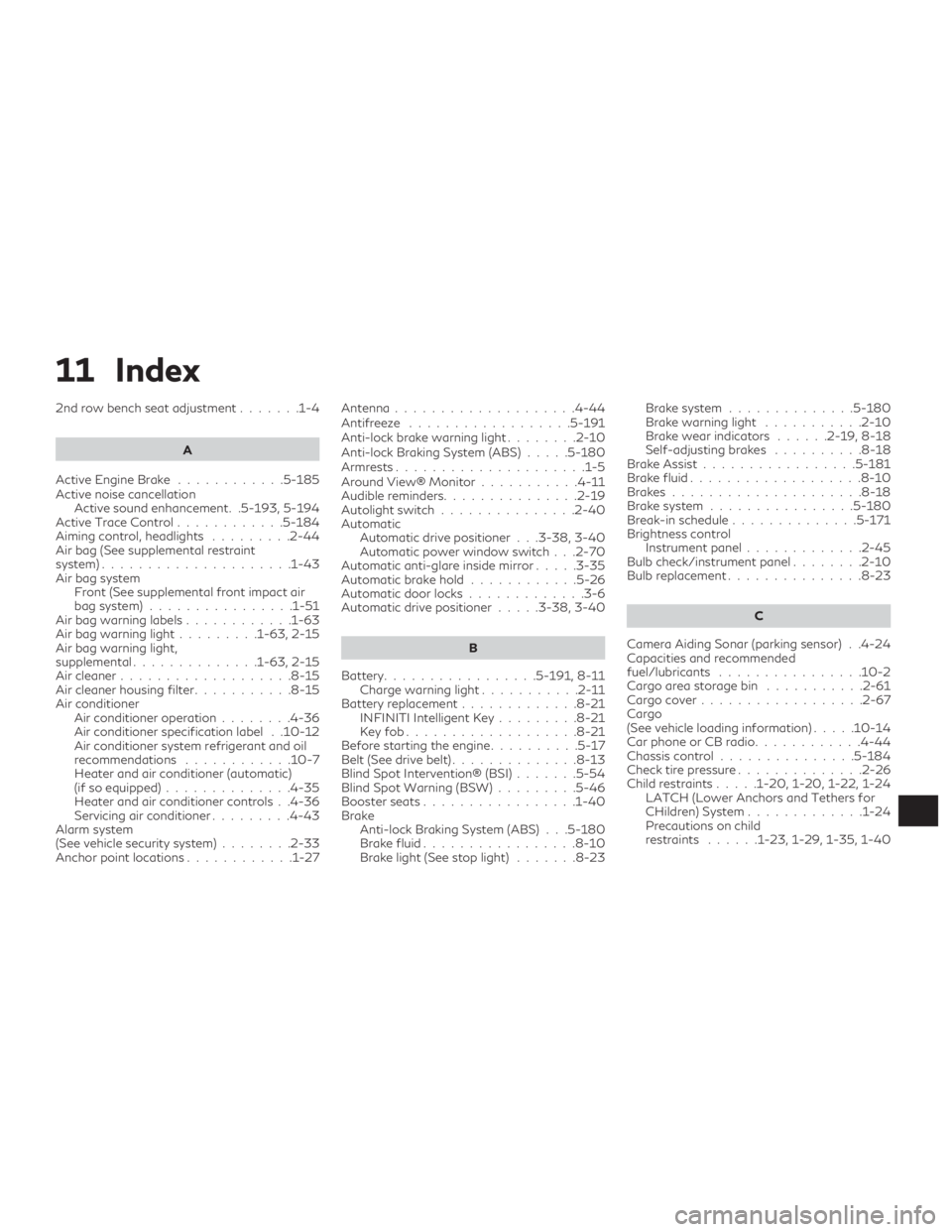
11 Index
2nd row bench seat adjustment.......1-4
A
Active Engine Brake ............5-185
Active noise cancellation Active sound enhancement. .5-193, 5-194
Active Trace Control ............5-184
Aiming control, headlights .........2-44
Air bag (See supplemental restraint
system).....................1-43
Air bag system Front (See supplemental front impact air
bag system) ................1-51
Air bag warning labels ............1-63
Airbagwarninglight.........1-63,2-15
Air bag warning light,
supplemental ..............1-63,2-15
Air cleaner ...................8-15
Air cleaner housing filter ...........8-15
Air conditioner Air conditioner operation ........4-36
Air conditioner specification label . .10-12
Air conditioner system refrigerant and oil
recommendations ............10-7
Heater and air conditioner (automatic)
(if so equipped) ..............4-35
Heater and air conditioner controls . .4-36
Servicing air conditioner .........4-43
Alarm system
(See vehicle security system) ........2-33
Anchor point locations ............1-27 Antenna
....................4-44
Antifreeze ..................5-191
Anti-lock brake warning light ........2-10
Anti-lock Braking System (ABS) .....5-180
Armrests.....................1-5
Around View® Monitor ...........4-11
Audible reminders ...............2-19
Autolight switch ...............2-40
Automatic Automatic drive positioner . . .3-38, 3-40
Automatic power window switch . . .2-70
Automatic anti-glare inside mirror .....3-35
Automaticbrakehold ............5-26
Automatic door locks .............3-6
Automatic drive positioner .....3-38,3-40
B
Battery.................5- 191, 8-11
Charge warning light ...........2-11
Battery replacement .............8-21
INFINITI Intelligent Key .........8-21
Keyfob...................8-21
Before starting the engine ..........5-17
Belt (See drive belt) ..............8-13
Blind Spot Intervention® (BSI) .......5-54
Blind Spot Warning (BSW) .........5-46
Boosterseats.................1-40
Brake Anti-lock Braking System (ABS) . . .5-180
Brakefluid.................8-10
Brakelight(Seestoplight) .......8-23 Brake system
.............. 5-180
Brakewarninglight ...........2-10
Brake wear indicators ......2-19,8-18
Self-adjusting brakes ..........8-18
Brake Assist .................5-181
Brakefluid...................8-10
Brakes.....................8-18
Brake system ................5-180
Break-in schedule ..............5-171
Brightness control Instrument panel .............2-45
Bulb check/instrument panel ........2-10
Bulb replacement ...............8-23
C
Camera Aiding Sonar (parking sensor) . .4-24
Capacities and recommended
fuel/lubricants ................10-2
Cargoareastoragebin ...........2-61
Cargocover.................. 2-67
Cargo
(See vehicle
loading information) .....10-14
Car phone or CB radio ............4-44
Chassis control ...............5-184
Check tire pressure .............. 2-26
Child restraints .....1-20,1-20, 1-22, 1-24
LATCH (Lower Anchors and Tethers for
CHildren) System .............1-24
Precautions on child
restraints ......1-23, 1-29, 1-35, 1-40
Page 566 of 580
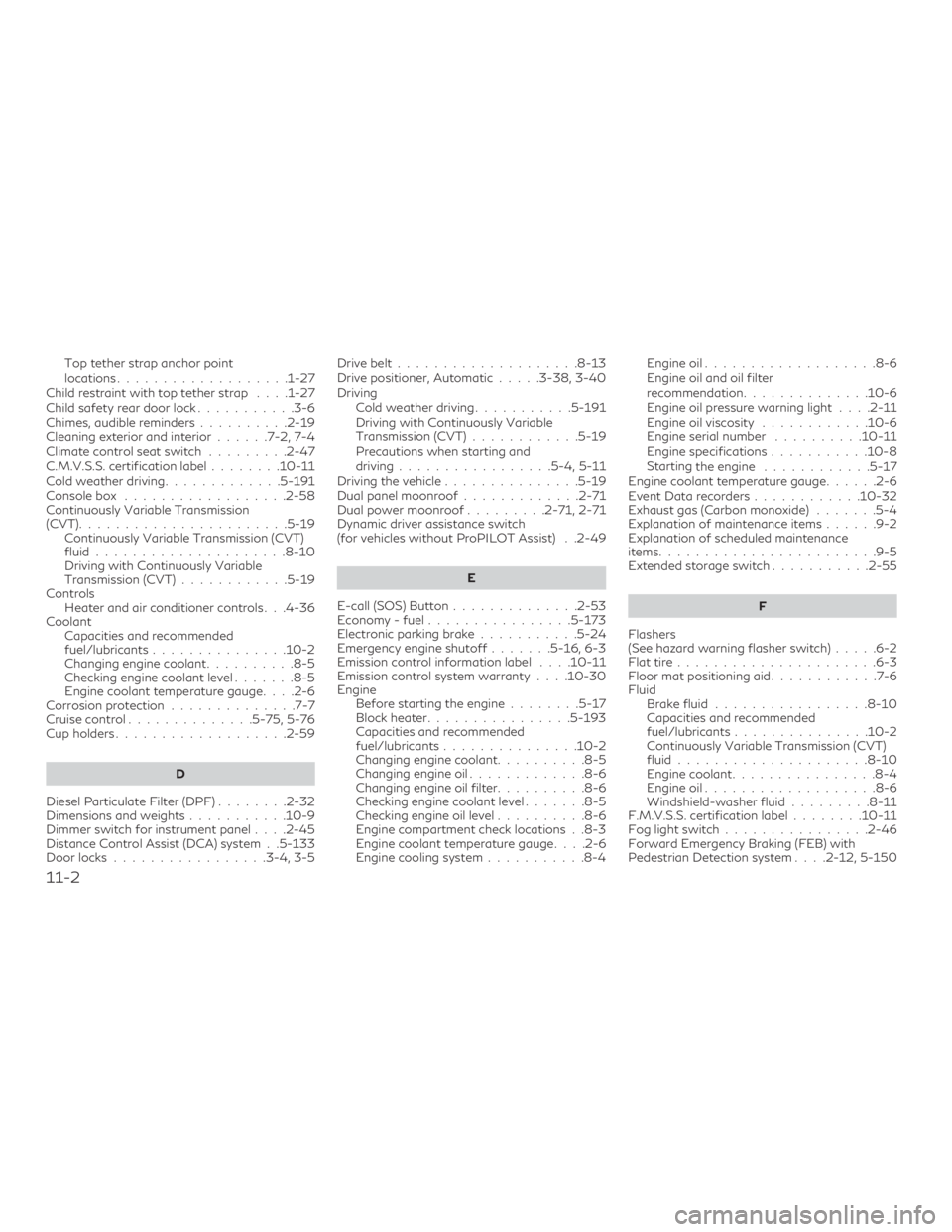
Top tether strap anchor point
locations...................1-27
Child restraint with top tether strap ....1-27
Child safety rear door lock ...........3-6
Chimes, audible reminders ..........2-19
Cleaning exterior and interior ......7-2,7-4
Climate control seat switch .........2-47
C.M.V.S.S. certification label ........10-11
Cold weather driving .............5-191
Console box ..................2-58
Continuously Variable Transmission
(CVT) .......................5-19
Continuously Variable Transmission (CVT)
fluid.....................8-10
Driving with Continuously Variable
Transmission (CVT) ............5-19
Controls Heater and air conditioner controls . . .4-36
Coolant Capacities and recommended
fuel/lubricants...............10-2
Changing engine coolant ..........8-5
Checking engine coolant level .......8-5
Engine coolant temperature gauge ....2-6
Corrosion protection ..............7-7
Cruisecontrol..............5-75,5-76
Cupholders...................2-59
D
Diesel Particulate Filter (DPF) ........2-32
Dimensionsandweights...........10-9
Dimmer switch for instrument panel ....2-45
Distance Control Assist (DCA) system . .5-133
Door locks .................3-4,3-5 Drivebelt....................8-13
Drive positioner, Automatic
.....3-38,3-40
Driving Cold weather driving ...........5-191
Driving with Continuously Variable
Transmission (CVT) ............5-19
Precautions when starting and
driving .................5-4,5-11
Driving the vehicle ...............5-19
Dual panel moonroof .............2-71
Dual power moonroof .........2-71,2-71
Dynamic driver assistance switch
(for vehicles without ProPILOT Assist) . .2-49
E
E-call (SOS) Button ..............2-53
Economy - fuel ................5-173
Electronic parking brake ...........5-24
Emergency engine shutoff .......5-16,6-3
Emission control information label ....10-11
Emission control system warranty ....10-30
Engine Before starting the engine ........5-17
Block heater ................5-193
Capacities and recommended
fuel/lubricants...............10-2
Changing engine coolant ..........8-5
Changing engine oil .............8-6
Changing engine oil filter ..........8-6
Checking engine coolant level .......8-5
Checking engine oil level ..........8-6
Engine compartment check locations . .8-3
Engine coolant temperature gauge ....2-6
Engine cooling system ...........8-4 Engine oil
...................8-6
Engine oil and oil filter
recommendation ..............10-6
Engine oil pressure warning light ....2-11
Engine oil viscosity ............10-6
Engine serial number ..........10-11
Engine specifications ...........10-8
Starting the
engine ............5-17
Engine coolant temperature gauge ......2-6
Event Data recorders ............10-32
Exhaust gas (Carbon monoxide) .......5-4
Explanation of maintenance items ......9-2
Explanation of scheduled maintenance
items........................9-5
Extended storage switch ...........2-55
F
Flashers
(See hazard warning flasher switch) .....6-2
Flat tire ......................6-3
Floor mat positioning aid ............7-6
Fluid Brakefluid .................8-10
Capacities and recommended
fuel/lubricants............... 10-2
Continuously Variable Transmission (CVT)
fluid.....................8-10
Engine coolant ................8-4
Engine oil ...................8-6
Windshield-washerfluid.........8-11
F.M.V.S.S. certification label ........10-11
Fog light switch ................2-46
Forward Emergency Braking (FEB) with
Pedestrian Detection system ....2-12,5-150
11-2
Page 567 of 580
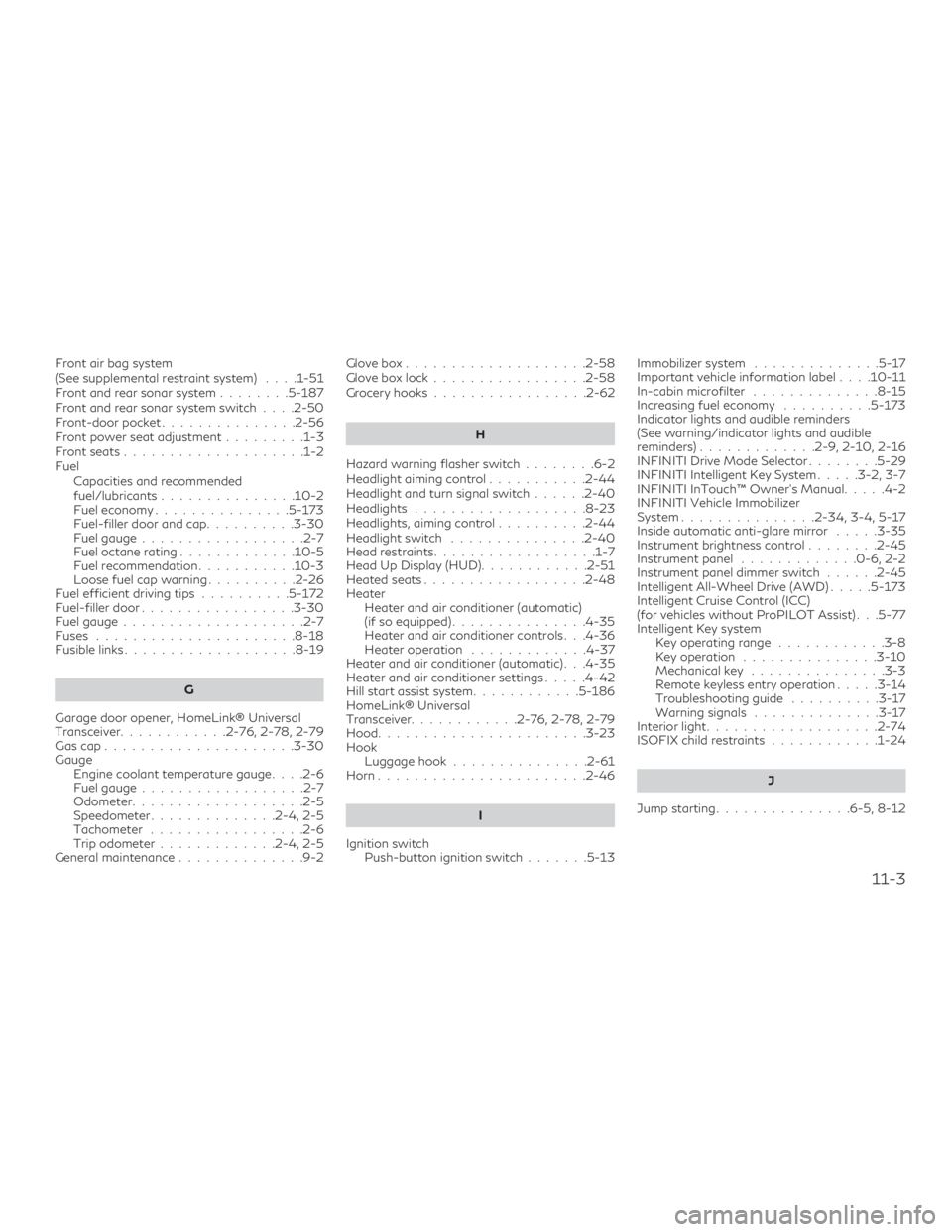
Front air bag system
(See supplemental restraint system)....1-51
Front and rear sonar system ........5-187
Front and rear sonar system switch ....2-50
Front-door pocket ...............2-56
Front power seat adjustment .........1-3
Frontseats....................1-2
Fuel Capacities and recommended
fuel/lubricants...............10-2
Fuel economy ...............5-173
Fuel-filler door and cap ..........3-30
Fuel gauge ..................2-7
Fueloctanerating.............10-5
Fuel recommendation ...........10-3
Loose fuel cap warning ..........2-26
Fuel efficient driving tips ..........5-172
Fuel-filler door .................3-30
Fuel gauge ....................2-7
Fuses ......................8-18
Fusiblelinks...................8-19
G
Garage door opener, HomeLink® Universal
Transceiver............2-76,2-78,2-79
Gascap.....................3-30
Gauge Engine coolant temperature gauge ....2-6
Fuel gauge ..................2-7
Odometer ...................2-5
Speedometer ..............2-4,2-5
Tachometer .................2-6
Trip odometer .............2-4,2-5
General maintenance ..............9-2 Glovebox....................2-58
Gloveboxlock.................2-58
Grocery hooks
.................2-62
H
Hazard warning flasher switch ........6-2
Headlight aiming control ...........2-44
Headlight and turn signal switch ......2-40
Headlights ...................8-23
Headlights, aiming control ..........2-44
Headlight switch ...............2-40
Head restraints ..................1-7
Head Up Display (HUD) ............2-51
Heated seats ..................2-48
Heater Heater and air conditioner (automatic)
(if so equipped) ...............4-35
Heater and air conditioner controls . . .4-36
Heater operation .............4-37
Heater and air conditioner (automatic) . . .4-35
Heater and air conditioner settings .....4-42
Hill start assist system ............5-186
HomeLink® Universal
Transceiver............2-76,2-78,2-79
Hood .......................3-23
Hook Luggage hook ...............2-61
Horn.......................2-46
I
Ignition switch Push-button ignition switch .......5-13Immobilizer system
..............5-17
Important vehicle information label . . . .10-11
In-cabin microfilter ..............8-15
Increasing fuel economy ..........5-173
Indicator lights and audible reminders
(See warning/indicator lights and audible
reminders) .............2-9,2-10,2-16
INFINITI Drive Mode Selector ........5-29
INFINITI Intelligent Key System .....3-2,
3-7
INFINITI
InTouch™ Owner's Manual .....4-2
INFINITI Vehicle Immobilizer
System ...............2-34,3-4,5-17
Inside automatic anti-glare mirror .....3-35
Instrument brightness control ........2-45
Instrument panel .............0-6,2-2
Instrument panel dimmer switch ......2-45
Intelligent All-Wheel Drive (AWD) .....5-173
Intelligent Cruise Control (ICC)
(for vehicles without ProPILOT Assist) . . .5-77
Intelligent Key system Key operating range ............3-8
Keyoperation ...............3-10
Mechanical key ...............3-3
Remote keyless entry operation .....3-14
Troubleshooting guide ..........3-17
Warningsignals ..............3-17
Interiorlight................... 2-74
ISOFIX child restraints ............1-24
J
Jump starting ............... 6-5, 8-12
11-3
Page 568 of 580
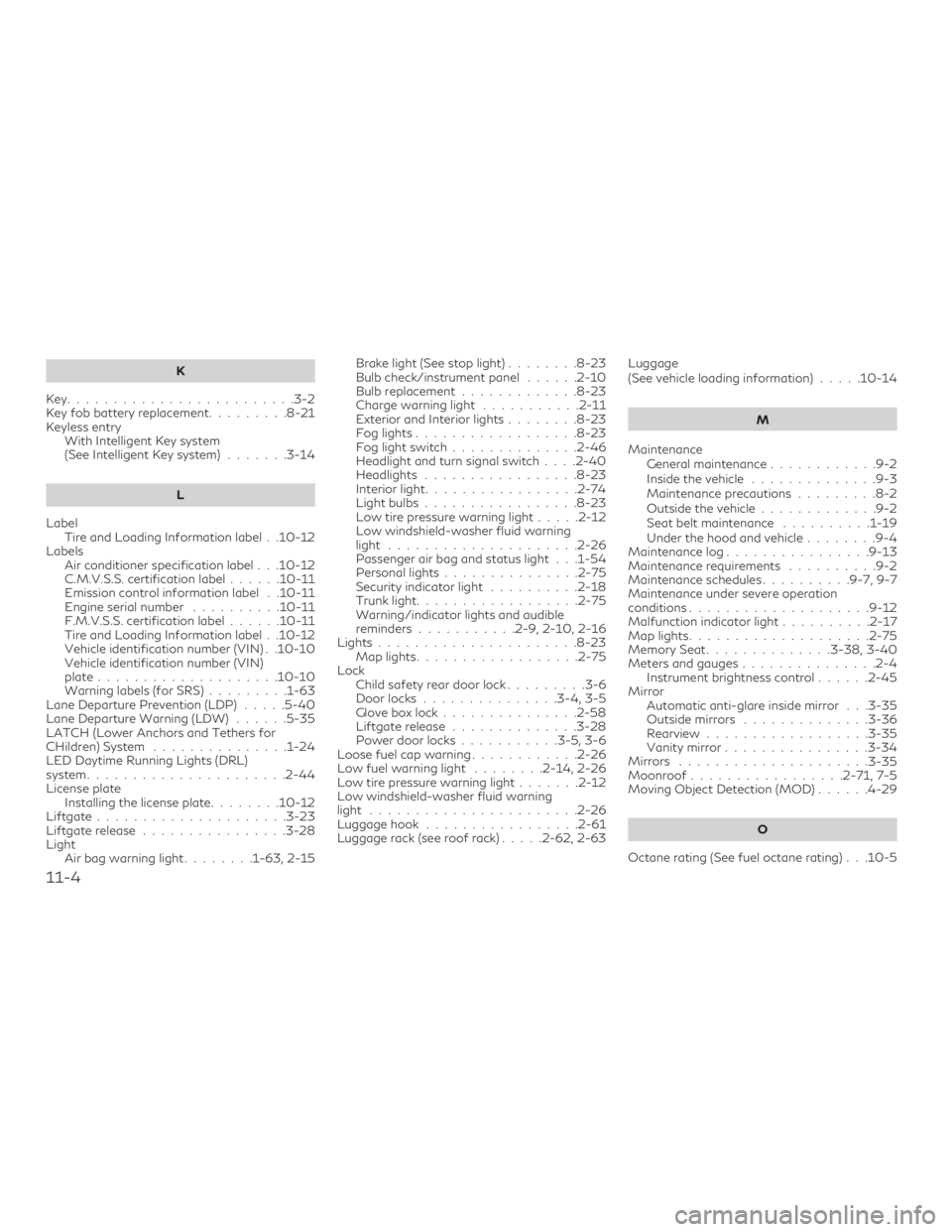
K
Key.........................3-2
Key fob battery replacement .........8-21
Keyless entry With Intelligent Key system
(See Intelligent Key system) .......3-14
L
Label Tire and Loading Information label . .10-12
Labels Air conditioner specification label . . .10-12
C.M.V.S.S. certification label ......10-11
Emission control information label . .10-11
Engine serial number ..........10-11
F.M.V.S.S. certification label ......10-11
Tire and Loading Information label . .10-12
Vehicle identification number (VIN) . .10-10
Vehicle identification number (VIN)
plate....................10-10
Warning labels (for SRS) .........1-63
Lane Departure Prevention (LDP) .....5-40
Lane Departure Warning (LDW) ......5-35
LATCH (Lower Anchors and Tethers for
CHildren)System ...............1-24
LED Daytime Running Lights (DRL)
system......................2-44
License plate Installing the license plate ........10-12
Liftgate.....................3-23
Liftgaterelease ................3-28
Light Airbagwarninglight........1-63,2-15 Brakelight(Seestoplight)........8-23
Bulb check/instrument panel
......2-10
Bulb replacement .............8-23
Charge warning light ...........2-11
ExteriorandInteriorlights........8-23
Foglights..................8-23
Fog light switch ..............2-46
Headlight and turn signal switch ....2-40
Headlights .................8-23
Interiorlight.................2-74
Lightbulbs.................8-23
Low tire pressure warning light .....2-12
Low windshield-washer fluid warning
light .....................2-26
Passenger air bag and status light . . .1-54
Personal lights ...............2-75
Security indicator light ..........2-18
Trunklight..................2-75
Warning/indicator lights and audible
reminders ...........2-9,2-10,2-16
Lights......................8-23 Maplights..................2-75
Lock Child safety rear door lock .........3-6
Door locks ...............3-4,3-5
Gloveboxlock...............2-58
Liftgaterelease ..............3-28
Power door locks ...........3-5,3-6
Loose fuel cap warning ............2-26
Lowfuelwarninglight ........2-14,2-26
Low tire pressure warning light .......2-12
Low windshield-washer fluid warning
light .......................2-26
Luggage hook .................2-61
Luggage rack (see roof rack) .....2-62,2-63Luggage
(See vehicle loading information)
.....10-14
M
Maintenance Generalmaintenance............9-2
Inside the vehicle ..............9-3
Maintenance precautions .........8-2
Outside the vehicle .............9-2
Seat belt maintenance ..........1-19
Under the hood and vehicle ........9-4
Maintenance log ................9-13
Maintenance requirements ..........9-2
Maintenance schedules ..........9-7, 9-7
Maintenance under severe operation
conditions....................9-12
Malfunctionindicatorlight..........2-17
Maplights.................... 2-75
Memory Seat ..............3-38,3-40
Meters and gauges ...............2-4
Instrument brightness control ......2-45
Mirror Automatic anti-glare inside mirror . . .3-35
Outside mirrors ..............3-36
Rearview .................. 3-35
Vanity mirror................ 3-34
Mirrors .....................
3-35
Moonroof ................. 2-71, 7-5
Moving Object Detection (MOD) ......4-29
O
Octane rating (See fuel octane rating) . . .10-5
11-4